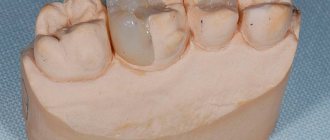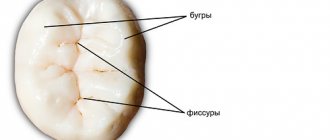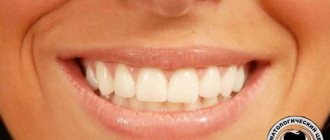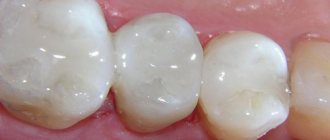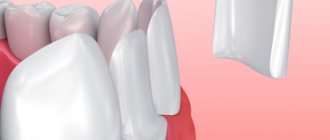Dental inlays
have been used in dental treatment for a long time, but many people still have not even heard of this technology for tooth restoration.
Meanwhile, a dental inlay is better than a large filling or crown. We decided to talk about microprosthetics with dental inlays with maxillofacial surgeon, dentist Tamara Kazbekovna Alakaeva
.
Tamara Kazbekovna, what is a dental inlay?
A dental inlay is a microprosthetic tooth that completely imitates its missing parts (anatomical and functional). The dentist prepares the tooth, takes an impression and sends it to the dental laboratory, after which the dental technician makes an inlay.
Is a dental inlay an alternative to a filling or crown?
Yes, today a dental inlay is a modern alternative to both a filling and a crown.
The inlay is more durable than a regular filling, since the filling contains various micropores, from which caries develops over time (microflora gradually accumulates in microcracks and micropores, causing the development of carious lesions). The inlay fits more tightly to the tooth, so nothing accumulates under it. In addition, the use of a dental inlay provides a more uniform and correct load on the tooth. Unlike fillings, ceramic inlays do not wear out over time and do not change in color or volume. All of the above qualities of dental inlays are their advantages over fillings and crowns.
The only disadvantages of dental inlays include, perhaps, the higher cost and the longer amount of time required for their manufacture. If a regular filling is installed for the patient directly on the day of the appointment, then the manufacture and installation of the inlay requires at least two visits with an interval of at least 7 days, since the dental inlay is made in a dental laboratory.
But the patient must understand that if the tooth is significantly damaged, then the installed filling will not last long. An inlay costs more than a filling, but it lasts about ten years, and with good hygiene – even longer. Many people change their fillings once a year or even every six months. Therefore, the tab is actually cheaper than several fillings that will have to be installed in its place.
How much does it cost to install one tab?
The price of the inlay consists of the cost of the material from which it is made and the work of the doctor and dental technician. In Moscow, a ceramic inlay for one tooth costs on average from 25 to 35 thousand rubles. In addition to ceramic, metal, plastic, composite, and zirconium inlays are installed. The insert can even be made from noble metals (gold).
It turns out that noble metals are still actively used in dental prosthetics?
Not really. Gold inlays
Usually installed on patients who are allergic to metal.
Such patients do not suspect that they have such an allergy and find out about it after the installation of the structure. Therefore, if a person has never had any artificial structure in the oral cavity, he needs to do an allergy test. Ceramic materials
, which are more expensive than metal, are not allergenic. This is their important advantage.
Composite
- this is a material used to make fillings; dental inlays are also made from it; they are about 30% cheaper than ceramic ones.
Made of plastic
Temporary structures are usually made. If the patient’s tooth is fully prepared for the installation of an inlay, and it is impossible to make a temporary filling, he can be given a temporary plastic inlay.
What is it - a tooth tab?
Dental inlays are microprostheses that can be used for different purposes. Restorative or restorative inlays are used like fillings: they help recreate the natural crown of a tooth, keeping it alive. Stump inlays are used in cases where it is necessary to restore a badly damaged tooth under a crown. Let's take a quick look at why restoration and stump inlays are used, and find out the difference between them.
Restoring inlays are stronger than conventional dental fillings and differ from them in the technology of their creation: dental inlays are not made directly in the patient’s mouth, like fillings, but in a dental laboratory, using previously taken impressions. Because microdentures are made in a laboratory setting, they are also called indirect dental inlays.
The inlays exactly repeat the shape of the cavity that needs to be closed for tooth restoration and fit tightly to the natural tissues. The high density of adhesion of the inlay to the tooth tissue eliminates the risk of developing caries in the gap between the installed microprosthesis and the tooth. Restoring a tooth with an inlay will help keep the tooth alive in a situation where a sufficient amount of tooth tissue has been preserved, its nerve is alive and well, but a large filling still needs to be placed. Large fillings do not stick well to the teeth and can break under stress, along with the tooth. Inlays have a long useful life, can withstand chewing loads well, and their use makes it possible not to rush into dental prosthetics with a crown, which often requires preliminary depulpation of teeth.
Stump inlays for a tooth are no longer a restoration element, but a technical one. It acts as a support for the installation of a dental crown in cases where the tooth cannot be restored qualitatively with a conventional filling. In order not to confuse stump and restoration inlays, the easiest way to classify them is as follows: restorative inlays are installed outside the living tooth, stump inlays are always located under the crown.
This is the main classification of inlays, but they can also differ in the type of material they are made of, and below we will definitely talk about all the types of microprostheses and their features. But first, let's find out who and when is recommended to install inlays on teeth.
Indications and contraindications for the use of dental inlays
Like any other procedure, microdental prosthetics have their own indications and contraindications. Indications include:
- severe carious destruction - up to 50%;
- tooth injury and, as a result, its destruction;
- wedge-shaped defect;
- dysplasia;
- hypoplasia.
Contraindications include: rapid carious destruction, caries on proximal surfaces, bruxism.
In any case, the doctor first conducts an examination and determines the most optimal method of tooth restoration; exceptions and additions to contraindications are always possible.
Indications for dental restoration with inlays
Let's look at all the cases in which the use of tabs may be indicated. It is recommended to use tabs:
- If the tooth is destroyed by more than 1/3;
- With increased wear of chewing teeth;
- When restoring teeth that in the future will have to act as a support for a crown or installation of a bridge;
- For large carious cavities in the teeth, the elimination of which with conventional fillings is ineffective.
The need to use inlays is determined by the dentist during the examination of the patient. Based on the clinical situation, the specialist will choose the type of microprosthesis that is suitable for you, both in terms of functionality and material of manufacture.
Types of restoration dental inlays: description, characteristics
In this section of the article, we will tell you about what restoration dental inlays can be, used in tooth restoration as an alternative to conventional fillings. Prostheses will be classified mainly according to the material of manufacture and according to this criterion, the inlays can be ceramic, composite, or metal. The material of the tooth inlay will affect both the performance characteristics of microprostheses and their cost.
Ceramic tooth inlay and its features
Most often, ceramic dental inlays are used to restore chips on living teeth and act as a high-quality and more reliable alternative to conventional fillings.
Ceramic inlays can only be placed on teeth that are alive, not loose, and have been treated for caries. Ceramic dental inlays have many advantages: they are aesthetically pleasing, durable, do not change their beautiful color even with prolonged use, and do not wear off. The high density of the marginal contact of the ceramic inlay with the natural tissues of the tooth eliminates the risk of developing secondary caries.
But ceramic dental inlays have some disadvantages. Some consider the disadvantages of ceramic inlays for teeth to be the high price of this type of microprosthesis in Moscow (from 8 thousand rubles), however, it should be noted that the high cost is fully justified by the long service life of ceramic inlays and their impeccable aesthetics. Please note that with ceramic inlays installed on your teeth, you will need to give up the habit of chewing nuts, crackers, and other types of too hard foods with your teeth. The ceramic inlay may not withstand such heavy loads!
Metal tooth tab: characteristics, pros, cons
Metal restoration inlays are used quite rarely these days, and all because microprostheses made from this material have a number of disadvantages:
- When installing metal inlays in the mouth, a very unpleasant galvanic side effect for the patient may occur, expressed in constant and profuse salivation, a pronounced metallic taste in the mouth;
- Installing metal inlays does not allow for high-quality and tight contact between the microprosthesis and the natural tissues of the tooth, and this increases the risk of developing secondary caries. Gold inlays on teeth can provide a good fit, but their price will be high, because gold is a noble and expensive metal;
- Metal inserts can cause allergic reactions;
- The aesthetics of metal inlays also leaves much to be desired.
The only significant advantage of metal inlays for teeth is the fairly low price for this type of microprosthesis in Moscow. The cost of a metal tab in the capital’s clinics starts at 4,000 rubles for one orthopedic product.
Composite inlays for teeth
Composite inlays are used to restore single-rooted teeth, which include incisors and canines, that is, the front teeth included in the smile area.
Installation of a composite inlay can only be carried out if the tissue in the tooth being restored is preserved in a volume of at least 50%. Composite inlays are also called pin inlays because when they are placed in the tooth canal, a pin is first placed on which the dentist will apply the composite material in layers. If the tooth is severely damaged, installing an inlay on a pin is not recommended, since over time the pin may begin to wobble in the tooth canal and its mobility can lead to a fracture of the tooth root. If your tooth is more than half destroyed, you do not need a restoration, but a stump inlay followed by installation of a crown!
How much will a composite tooth inlay cost? The answer to this question will depend on what type of post and composite material the dentist uses during the restoration process.
The price of a restoration insert will also depend on the method of its manufacture. All inlays, except composite ones, are created in the laboratory using dental impressions. The tooth for the inlay must be ground down, although the volume of tissue removed will be less than the amount of dental tissue that is removed for the crown. The most complex manufacturing technology is for ceramic crowns, which are made from pressed ceramics: they are created using CAD/CAM computer technology. The complexity of the technology increases the price of ceramic inlays, but such microprostheses will have high anatomical accuracy, which means they will last longer.
Sign up to install an E-Max tab at a discount:
But the most common material for dental inlays is ceramic?
Yes, today the most popular material for inlays is E-Max ceramics. This material is also used to make veneers. E-Max ceramics is a modern, aesthetic material that interacts very well with tooth tissue. Such an inlay is attached to the tooth adhesively; this is the strongest adhesion of ceramic restorations to the tooth’s own tissues. Thanks to this technology, the boundaries between the tooth and the inlay are practically invisible. The tooth and the tab fixed to it actually become one whole.
Is the tooth being filed down heavily under the inlay?
Almost the same as for a filling. The only thing is that the tooth tissue is cut down at certain angles, taking into account the installation of the inlay.
If a tooth is badly damaged, is it possible to put an inlay on it?
Yes, you can. Of course, most often inlays are placed on “living” (non-pulpless) teeth that have large cavities, that is, an inlay is placed instead of a large filling. But if necessary, the tab can also be placed on a “dead” (pulpless) tooth. The inlay can last on a “dead” tooth for several years without chipping or breaking.
But it is important to understand that a “dead” tooth does not receive nutrition and is more fragile, so if the load is incorrect, it can break.
Are dental inlays only placed on chewing teeth?
Most often, inlays are placed on chewing teeth. Veneers are usually installed on the front teeth.
Some people complain that after installing this micro dental prosthesis - inlays, the tooth hurts. Why does this happen and what to do in this case?
After the inlay is installed correctly, the tooth should not be disturbed. However, if this happened, then most likely the reason is that the doctor did not follow the procedure protocol
.
An assistant prepares the inlay before installation, and the doctor prepares the tooth. When installing a ceramic inlay, it is very important to isolate the tooth from saliva using a special latex scarf (rubber dam), which isolates the tooth from saliva so that no microflora gets on the prepared tooth. The tooth tissue is treated with a special liquid that eliminates sensitivity.
It should also be noted that all people have different sensitivity; for some, after dentures, the teeth ache during the first 2 weeks - which is normal; for others, they do not hurt at all.
So, if a patient’s tooth hurts for some time after the installation of an inlay, is there a possibility that this pain will subside over time?
Yes, sure. There are so-called “post-filling pains”. The treated tooth may ache for some time when biting after dental treatment. Therefore, it is necessary to give a certain time for recovery. This time varies for each patient, but on average up to one month.
And if the tooth does not subside and continues to hurt, what should you do?
The doctor must analyze the causes and nature of the pain. Often, painful sensations after dental treatment are due to the fact that the patient has an inflamed nerve due to the fact that he has caught a cold. It happens that this neuralgia is associated with stress. There are many reasons, and sometimes they are not related to the work of the dentist. Therefore, in case of pain, it is necessary not only to take photographs of the tooth (X-ray, computed tomography), check the sensitivity of the tooth with a special device, but also analyze the general condition of the patient.
Which tooth is better to place an inlay on – healthy or pulpless?
If possible, it is advisable to install the inlay on a living tooth. Before the procedure, the doctor takes an x-ray. Using it, a specialist looks at the condition of the dental canals and tissues located around the tooth. E-Max ceramics (I-Max) bond better with the tissues of living teeth. By examining an x-ray and the causative tooth in the patient’s mouth, the doctor decides what type of inlay or crown is best to install on the tooth. If it becomes clear to the doctor that the tab cannot withstand the load, then a crown is installed.
How are restoration inlays installed on teeth?
Installing a restorative inlay on teeth is a multi-step process that always begins with a detailed diagnosis, which will include examination, radiography and computed tomography. After the diagnosis, the type of inlay is selected and a detailed treatment plan is drawn up.
The tooth on which the inlay is planned to be placed is ground down and then an impression is taken from it and sent to a dental laboratory. An inlay will be made based on the impression and the average production time is 5-7 days.
When the inlay is ready, the patient is invited to the clinic for fitting and installation of a microprosthesis. The inlay is fixed in the tooth cavity using special dental cement.
Advantages and disadvantages of tabs
- There is no danger of destruction or cracking - the strength and reliability of the inlays is high.
- Resistance to food dyes, color stability.
- The characteristics of the bite are taken into account.
- The shape of the tooth is completely restored and remains unchanged in the future.
- There are no unpleasant sensations at all.
- The result of tooth restoration is highly aesthetic.
- The possibility of the spread of harmful organisms is eliminated.
Negative aspects may arise if you go to clinics with insufficient equipment or inflated prices. In these cases, patients note the lengthy process of manufacturing and installing the inlay and the high cost.
Is it possible to put an inlay on the front teeth?
Inlays are not used for the restoration of anterior teeth. If there is a sufficient amount of healthy tooth tissue, the tooth is restored with a regular filling and then a veneer or lumineer can be placed on it to obtain a beautiful aesthetic restoration in the smile area. If the tooth is severely damaged, then it makes sense to install a stump tab and then a crown.
The traditional area of application for restoration inlays is chewing teeth.
Dental inlays in dentistry: pros and cons
The advantages here are obvious:
- The design is reliable and durable - it can withstand heavy loads, sits tightly in the gum, does not wear out externally, and the restoration of such a tooth will last more than 12 years;
- Suitable for severely damaged, chipped teeth.
Of the minuses:
- The cost is higher than treatment with structures made of pins and fillings;
- If necessary, a 2- and 3-channel disassembled insert must be installed by a professional who still needs to be found.
Can a tooth get sick under an inlay and what to do if this happens?
If the tooth under the inlay hurts, you need to urgently contact a dental clinic, because pain under the installed microprosthesis can indicate the development of various kinds of complications. The main cause of complications after installing an inlay is medical errors that were made during the treatment process, and that is why it is so important to choose dentistry carefully! If, when treating a tooth, the doctor allows the pulp to overheat, an inflammatory process may begin, as a result of which the tooth under the tab will become sore. To eliminate pulpitis, you will have to remove the tooth inlay, receive appropriate treatment, and then restore the tooth again, possibly with a prosthetic crown or even implantation.
Inlays are often placed on teeth after caries treatment and it is extremely important that when working with a carious cavity, the dentist removes all destroyed tissue. If this is not done, secondary caries will begin under the tab, the treatment of which will again require removal of the tab.
Remember that if 5-7 days have passed after installing the inlay on the tooth, and your tooth hurts and the intensity of the pain is increasing, you need to urgently see a dentist, and not try to solve the problem yourself! If the infection gets into the root part of the tooth, it is not always possible to save the tooth and avoid its removal!
If the tooth does not hurt, but you have the feeling that it is bothering you - when eating, talking, trying to close your teeth - contact the clinic where you received the inlay to have its size corrected.
Treatment methods
If a tooth without a nerve hurts under the crown, the specialist will determine the cause of the pain and apply the most appropriate treatment method. Most often, the artificial crown is removed, as it will interfere with the treatment. But sometimes specialists carry out therapy without removing the structure. A small hole is made on the chewing surface of the tooth and crown through which treatment procedures are carried out. Depending on the clinical situation and the cause of tooth pain under the crown, treatment tactics may be as follows:
- Removing the crown and making a new one. The doctor eliminates the inflammatory process, treats and re-seals the canals.
- Crown removal, treatment and re-fixation. If possible, after treatment, the doctor can install the same crown on the tooth. But this method is rarely used, since more often the structure is deformed during removal.
- Treatment through a crown. Treatment of lateral teeth in some cases can be carried out through the structure, provided there is good access.
- Removing the crown and performing tooth-preserving surgery. To preserve the tooth as a functional unit, operations are used that involve removing the source of inflammation with part of the tooth: hemisection (removal of one root), coronary-radicular separation (removal of half the tooth), resection of the apex (removal of the upper part of the root from the sites of inflammation, cyst) .
- Tooth extraction is a last resort measure of treatment, which is used when it is impossible to save the tooth with therapeutic methods.
Stump inlays: what do you need to know about them?
At the very beginning of our article, we said that stump inlays should not be confused with restorative microprostheses - they are used to restore pulpless and severely damaged teeth, in which they will serve as the basis for installing a crown or dental bridge.
Stump inlays are structures consisting of two parts: a pin installed in the root canal and a support on which the crown will be fixed. Stump inlays can be monolithic or collapsible, and most often this type of structure is used when the tooth has less than 50% of healthy tissue left.
Many people are interested in the question: why is it best to use core inlays rather than fillings on a pin to restore severely damaged teeth? The fact is that the pin may not withstand the load and begin to wobble in the canal, and this will either lead to the filling breaking or falling out, or, worst of all, to damage to the tooth root, in which the tooth is most often removed. Stump inlays allow you to avoid such risks because they distribute the load more correctly and themselves have much greater strength compared to pins.
Stump inlays are also made in the laboratory and the construction material is selected to match the type of dental crown that is planned to be placed in the future. Metal core inlays are used for metal-ceramic crowns, and zirconium inlays are used for ceramic crowns. If you make a metal inlay for a ceramic crown, it can shine through the thin and transparent material of the crown, which will have a bad effect on the aesthetics of the restoration.
Tooth restoration using a core inlay will also be divided into several stages: diagnostics, preparation, during which a cavity is formed in the tooth for the inlay, manufacturing of the inlay, and its installation. After installing the core tab, the crown is fixed on it and this completes the process of tooth restoration.
If the tooth is destroyed, but there is a living nerve in it, before installing the stump tab, depulpation is carried out, as well as treatment and filling of the root canals. It is important that these procedures are carried out without errors, since poor canal processing leads to various kinds of complications, the elimination of which requires complex and lengthy treatment.
How to care for your tabs
After microprosthetics with inlays, you must strictly follow all the doctor’s recommendations. Heavy loads on the tooth should be avoided; soft or liquid foods are preferable in the first few days. It is best to avoid smoking, excessive consumption of coffee, alcohol, and drinks with dyes.
Behind the tabs
your teeth
in the same way as regular - brush twice a day, use mouth rinses, and visit the dentist regularly.
Where to go
If you have a problem and require dental restoration and prosthetics using inlays, pay attention to our dental clinic “DentAl”. We have good professionals who will conduct an examination, select the best option for tooth restoration, make an accurate inlay and install it. The cost of the service will directly depend on the complexity of the work and the materials used to make dental inlays. Average price for installing tabs
from composite - from 4,000 rubles, from ceramics - about 8,000 rubles.
Attention!
Fixing the tab may be paid separately.
We offer clients only high-quality and proven services, and this has already been appreciated by a huge number of patients.
Tab lifespan
The service life of restoration inlays will depend on the material and production technology of microprostheses, as well as on how accurately the patient follows the dentist’s recommendations. Composite inlays last about 5-7 years, ceramic inlays - up to 20 years. This is subject to high-quality dental and oral hygiene and regular visits to the clinic for preventive examinations.
Stump inlays can last you a lifetime, and crowns on them last up to 15-20 years.
Do you still have questions about restorative and core dental inlays? Ask them to the orthopedists of our dentistry in Moscow - Vanstom! You can make an appointment with the clinic’s doctors at any time convenient for you - through the chat on our website, the call back form, or simply by dialing the contact phone number!
